A major earthquake off the coast of Russia has sparked tsuanami alerts across the Pacific A pedestrian crosses and empty Ala Moana Boulevard ahead of an anticipated tsunami on July 29, 2025 in Honolulu, Hawaii(Image: Getty Images)
A pedestrian crosses and empty Ala Moana Boulevard ahead of an anticipated tsunami on July 29, 2025 in Honolulu, Hawaii(Image: Getty Images)
Countries surrounding the Pacific Ocean including the USA, Japan and New Zealand are on alert for tsunamis after an 8.8-magnitude earthquake struck Russia’s far east.
The UK Foreign Office has issued travel alerts for 17 countries, spanning Canada in the north to the Pacific Islands in the south.
People are being urged to move to higher ground around the Pacific region and to avoid areas by the shore.
Most places where tsunami waves have already washed ashore have reported no significant damage so far. A tsunami height of 10-13ft was recorded in Kamchatka, 2ft on Japan’s northern island of Hokkaido, and up to 1.4 feet above tide levels were observed in Alaska’s Aleutian Islands.
Never miss a story with the MEN’s daily Catch Up newsletter – get it in your inbox by signing up here
The UK Foreign Office update issued for the countries at risk reads: “An earthquake with a preliminary magnitude of 8.7 has struck the eastern coast of Russia in the Kamchatka Peninsula region.
 A traffic jam forms in Honolulu Tuesday, July 29, 2025 as people heed a tsunami evacuation warning that coincided with rush hour following a powerful earthquakes in Russia’s Far East early Wednesday(Image: AP)
A traffic jam forms in Honolulu Tuesday, July 29, 2025 as people heed a tsunami evacuation warning that coincided with rush hour following a powerful earthquakes in Russia’s Far East early Wednesday(Image: AP)
“A tsunami threat message has been issued by the Pacific Tsunami Warning Centre. If you are in the affected areas potentially affected by the earthquake or tsunami you should follow the advice of the local authorities.”
The UK Foreign Office has issued updates for the following countries:
ChileKiribatiFrench PolynesiaPeruUSASamoaJapanSolomon IslandsEcuadorRussiaNew ZealandTongaChinaTaiwanPhilippinesCanadaCosta Rica
The impact of the tsunami could last for hours or perhaps more than a day, according to Dave Snider, tsunami warning coordinator with the National Tsunami Warning Centre in Alaska.
“A tsunami is not just one wave,” he said. “It’s a series of powerful waves over a long period of time. Tsunamis cross the ocean at hundreds of miles an hour – as fast as a jet aeroplane – in deep water.
“But when they get close to the shore, they slow down and start to pile up. And that’s where that inundation problem becomes a little bit more possible there.
 Travelers are waiting in Tokyo Station under a sign announcing the cancellation of some trains following a tsunami alert on July 30, 2025, in Tokyo, Japan(Image: Anadolu via Getty Images)
Travelers are waiting in Tokyo Station under a sign announcing the cancellation of some trains following a tsunami alert on July 30, 2025, in Tokyo, Japan(Image: Anadolu via Getty Images)
“In this case, because of the Earth basically sending out these huge ripples of water across the ocean, they’re going to be moving back and forth for quite a while,” which is why some communities may feel effects longer, he added.
Hawaii governor Josh Green said data from Midway Atoll, which is between Japan and Hawaii, measured waves from peak to trough of 6ft.
He said waves hitting Hawaii could be bigger or smaller and it is too early to tell how large they would be. A tsunami of that size would be akin to a 3ft wave riding on top of surf, he said.
“This is a longitudinal wave with great force driving through the shoreline and into land,” he said at a news conference.
Mr Green said Black Hawk helicopters have been activated and high-water vehicles were ready to go in case authorities need to rescue people. “But please do not put yourself in harm’s way,” he added.
The quake at 8.25am Japan time (12.25am BST) had a preliminary magnitude of 8.0, Japan and US seismologists said. The US Geological Survey later updated its strength to 8.8 magnitude and the USGS said the quake occurred at a depth of 13 miles.
The quake was centred about 74 miles east-southeast from the Russian city of Petropavlovsk-Kamchatsky, which has a population of 180,000, on the Kamchatka Peninsula. Multiple aftershocks as strong as 6.9 magnitude followed.
The first tsunami wave hit the coastal area of Severo-Kurilsk, the main settlement on Russia’s Kuril Islands in the Pacific, according to the local governor Valery Limarenko. He said residents were safe and staying on high ground until the threat of a repeat wave was gone.
About 2,700 people were evacuated to safe locations on the Kuril Islands. Buildings were damaged and cars swayed in the streets in Petropavlovsk-Kamchatsky. Russian news agencies quoting the regional Health Ministry said several people sought medical help in Kamchatka after the earthquake but no serious injuries were reported.
The earthquake appears to be the strongest anywhere in the world since the 9.0 magnitude earthquake off north-eastern Japan in March 2011 that caused a massive tsunami that set off meltdowns at a nuclear power plant. Only a few stronger earthquakes have ever been measured around the world.
The tsunami alert disrupted transportation in Japan, with ferries, trains and airports in the affected area suspending or delaying some operations.
A tsunami of 2ft was recorded at Hamanaka town in Hokkaido and Kuji port in Iwate, according to the Japan Meteorological Agency. Several areas reported smaller waves including 8in in Tokyo Bay five hours after the quake.
In Japan’s northern coastal town of Matsushima, dozens of residents took refuge at an evacuation centre, where water bottles were distributed and an air conditioner was running. One person told NHK she came to the facility without hesitation based on the lesson from the 2011 tsunami.
Japanese nuclear power stations have reported no abnormalities.
The operator of the Fukushima Daiichi plant damaged by the 2011 tsunami said about 4,000 workers are taking shelter on higher ground at the plant complex while monitoring remotely to ensure plant safety.
For more of today’s top stories, click here.


AloJapan.com